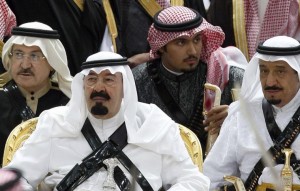[caption id="attachment_91881" align="alignright" width="180"] Saudi King Abdullah bin Abdulaziz (L) attending a conference with his entourage. (Photo: AFP)[/caption]
Saudi King Abdullah bin Abdulaziz (L) attending a conference with his entourage. (Photo: AFP)[/caption]
Oil rose after the death of�King Abdullah�of�Saudi Arabia, the biggest producer in the Organization of Petroleum Exporting Countries.
Futures rallied as much as 3.1 percent in�New York�and 2.6 percent in�London�after the Saudi royal court announced the death in a statement. Crown Prince Salman bin Abdulaziz will succeed Abdullah on the throne. The kingdom, the world�s largest crude exporter, led OPEC�s decision to maintain its oil-production quota at a meeting in November, exacerbating a global glut that�s driven prices lower.
�The passing of King Abdullah is going to increase uncertainty and increase volatility in�oil prices�in the near term,��Neil Beveridge, a Hong Kong-based analyst at Sanford C. Bernstein & Co., said by phone. �I wouldn�t expect a change in policy in the near term to be known, but the passing comes at a challenging time for Saudi Arabia.�
Oil Prices
Oil fell almost 50 percent last year as the U.S. pumped at the fastest rate in more than three decades and OPEC resisted calls to cut output.�Crude stockpiles�in the U.S., the world�s biggest oil consumer, rose by 10.1 million barrels through Jan. 16, the Energy Information Administration reported on Thursday. That was the biggest volume gain since March 2001.
Policy Uncertainty
West�Texas�Intermediate for March delivery climbed as much as $1.45 to $47.76 a barrel in electronic trading on the�New York Mercantile Exchange�and was at $47.05 at 3:44 p.m. Singapore time. The contract dropped $1.47 to $46.31 on Thursday. Total volume was about 41 percent above the 100-day average. Prices have decreased 3.3 percent this week.
Brent for March settlement advanced as much as $1.28 to $49.80 a barrel on the London-based ICE Futures Europe exchange. The European benchmark crude traded at a premium of $2.36 to WTI, compared with $1.04 on Jan. 16.
King Abdullah oversaw a fivefold expansion in the size of the Arab world�s biggest economy and met the Arab Spring with a mixture of force and largesse. He died after almost a decade on the throne. He was born in 1924.
�The market is reacting bullishly to this news because it may usher in a period of uncertainty as far as Saudi policies going forward as new leadership takes over,� said�Andy Lipow, the president of Lipow Oil Associates LLC, an energy consultant in Houston, Texas.
Market �Tensions�
King Salman, in his previous capacity as crown prince, read a speech on behalf of the monarch on Jan. 6 that confirmed the continuity of Saudi oil policy in the face of market �tensions� caused by slow growth in the global economy.
A key indicator will be whether Salman, 79, retains the oil minister, Ali Al-Naimi, who has driven decision-making since 1995. Al-Naimi, who turns 80 this year, has said he�d like to devote more time to his other job as the chairman of the science and technology university named after the late sovereign.
�There�s the possibility that�Ali al-Naimi�could be replaced as oil minister,� said�Phil Flynn, a senior market analyst at the Price Futures Group in�Chicago. �The biggest concern is uncertainty. But, because the world is awash in oil, the reaction was muted.�
The king�s death also raises the question of whether instability across the�Middle East�will intensify, according to Flynn. King Abdullah had �done a good job trying to subdue� insurgents in the country, and Saudi Arabia may face increasing pressure from them now that he�s gone, he said.
Global Supplies
Middle East nations account for half of OPEC�s 12 members. The group, which supplies about 40 percent of the world�s oil, maintained its collective production target at 30 million barrels a day at a Nov. 27 meeting in Vienna. Output averaged 30.2 million in December, data compiled by Bloomberg show. Saudi Arabia pumped 9.5 million a day last month.
�Any form of economic instability after the death of the king will create a little bit of uncertainty,� said�Jonathan Barratt, the chief investment officer at Ayers Alliance Securities in Sydney. �The market is exceptionally short, so even if there�s a bit of a slight err, you could see a rally of some substance. The supply story is still out there.�
U.S. crude inventories have risen to 12 percent above the five-year average for this time of year, based on Thursday�s report from the EIA, the Energy Department�s statistical arm. Production surged to 9.19 million barrels a day through Jan. 9, the most in weekly records dating back to January 1983.
In�China, Saudi Arabia�s share of crude sales shrank for a second year as the Asian nation bought more from�Russia. The world�s second-largest consumer imported 49.67 million metric tons of Saudi oil last year, according to General Administration of Customs data e-mailed Friday. That�s about 997,000 barrels a day, the least since 2010.
By Bloomberg
The Iran Project is not responsible for the content of quoted articles.

 QR code
QR code